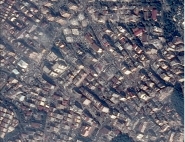System
The Pleiades system is a dual system which purpose is to deliver high resolution optical images to defence clients as well as civilian clients, while respecting the strong requirements of each one.
The system reconciles civilian needs:
- Diversity of users (institutional uers, GMES, scientific users, commercial users)
- Access to the system from public network
with defence needs:
- Priority given to defence programmation
- Classification of the defence order book
- Protection of communication networks as well as User Centers and Command-Control Centers
while implementing common needs:
- Numerous images
- System flexibity (agility, answer to the emergency)
- Access and revisit delays
- System perenniality through time.
- Orbit:
- Sunsynchronous, phased and quasi-circular at 694 km.
- 26 days cycle and local time 10h15 at the descending node.
- 180° dephasing between the two satellites
- Global access:
With one satellite: in 2 days (require a viewing angle of 47°)
With two satellites: daily (a viewing angle of 43° is enough).
![]()
Example of accessible areas with only one satellite
each day with a depointing of 30°
![]()
Example of accessible areas with two satellites
each day with a depointing of 30°
Main characteristics:
- Data acquisition
- 300 images per day per satellite on average
- Only one acquisition mode:
simultaneously panchromatic + multispectral.
- Agility
- Roll pitch:
- 5° in 8 secondes
- 10° in 10 secondes
- 60° in 25 secondes
- Stereoscopy and tri-stereoscopy along track.
- Mosaics in one pass.
Acquisition capabilities over large area:
The following diagram illustrates the satellite capabilities to image a 1000 x 1000 km² area, during a single fly-by, with about 20 targets in one pass for a depointing of 20°.
- "Instantaneous" capabilities:
- Commercial mission over Europe:
- 40 targets of 15 km diameter accessible on the orbit,
- Over an interest area of 1000 x 1000 km².
- Commercial mission over Europe:
| Satellite capabilities to image a 1000 x 1000 km² area, during a single fly-by, with about 20 targets in one pass for a depointing of 20° |
Acquisition capabilities over small area:
The following diagram illustrates the satellite capabilities to image a crisis area during a single fly-by. The results are given for the case where the user has limited the authorized viewing angle to 20°.
- "Instantaneous" capabilities:
- Crisis operational scene:
- 30 targets of 15 km diameter accessible on the orbit,
- Over an interest area of 100 x 200 km².
- Crisis operational scene:
| Satellite capabilities to image a 100 x 200 km² area, during a single fly-by, with about 10 targets in one pass for a depointing of 20° |
Stereoscopic cover capabilities
A great innovation of the Pleiades system is to offer a stereoscopic cover capability with a high resolution. The stereoscopic cover is realized by only one flyby of the area, which enables to get an homogeneous product quickly.
As shown below, the system offers the possibility to realise a "classical" stereoscopic imaging, composed of two images for which the angular difference (B/H) can be adjusted, but also stereoscopic imaging with an additional quasi vertical image (tri-stereoscopy), thus enabling the user to have an image and its stereoscopic environment.
| Stereo | and | Tri-stereo | ||||||||||||||||||||||||||||
|
|
The tables show the maximal length of the possible bands in stereo and tri-stereoscopic conditions depending on the required B/H.
The system also offer, by its great agility, the possibility to artificially increase the instantaneous field of view.
The following table shows this capability, depending on the depointing angle authorized by the user.
| ||||||||||||||||||||||
The system currently enables to program two work plans per day (12 hours chronology):
- Morning around 6h TU.
- Evening around 19h TU.
The following scheme shows the access delays all over the Earth according to this chronology:
![]()
Under study: the possibility to have a chronology of three work plans per day to decrease the delays over the american continent.
